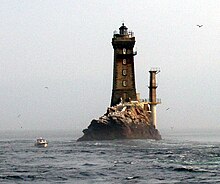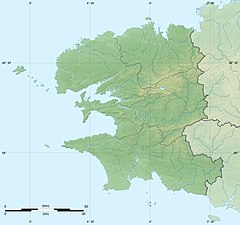La Vieille

La Vieille
|
|
|
Finistère
|
|
| Location |
Raz de Sein Finistère Brittany France |
|---|---|
| Coordinates | 48°02′26.8″N 4°45′23.2″W / 48.040778°N 4.756444°W |
| Year first constructed | 1887 |
| Year first lit | 1887 |
| Construction | granite, kersantite |
| Tower shape | tapered square prism tower with balcony and lantern |
| Markings / pattern | unpainted tower with an upper black band, black lantern |
| Height | 27 m (89 ft) |
| Focal height | 33 m (108 ft) |
| Original lens | 4/5 horizon lens, 50 cm focal length, 3 m |
| Light source | solar power |
| Intensity | 250 W halogen lamp |
| Range | 18 nautical miles (33 km) |
| Characteristic |
Oc (2+1) WRG 12s. |
| Fog signal | ELAC-ELAU 2200 vibrator (2+1 blasts every 60 seconds) |
| Admiralty number | D0870 |
| NGA number | 0272 |
| ARLHS number | FRA-027 |
| France number | FR-0700 |
| Heritage | registered historic monument |
|
[]
|
|
Oc (2+1) WRG 12s.
La Vieille ("The Old Lady" or "The Wrass") is a lighthouse in the département of Finistère at the commune of Plogoff, on the northwest coast of France. It lies on the rock known as Gorlebella (Breton for "farthest rock"), guiding mariners in the strait Raz de Sein, across from the companion lighthouse Tourelle de la Plate—also known as Petite Vieille ("Little Old Woman"). It is among the small class of lighthouses around the coasts of France carrying the moniker "hell", due to a remote position in rough seas.
Initial planning talks began as early as 1861, though the construction project was not confirmed until twenty years later. Fierce tides limited the period in which building work could take place to less than half of each year. After five years, construction was complete and its beam first shone in 1887. The light is occulting, with a range of 18 nautical miles (33 km); a foghorn was installed in the early twentieth century.
La Vieille achieved notoriety in the 1920s when two disabled war veterans were stranded there for weeks by storms, their health deteriorating. They were employed under a new law reserving the job of lighthouse keeper to those who had served in the war. The tremendous difficulties experienced in getting them back to shore led to the repeal of the new law. In 1995 it was the penultimate French lighthouse to become automated, a process delayed due to the keepers on-site staging a protest against the task being carried out.
On 30 November 1861, the French Commission des Phares (the Lighthouse Commission) decided in favour of constructing a "3rd order" lighthouse on Gorlebella rock, inviting engineers to carry out a pilot study the following year. The study was postponed, however, due to funding difficulties as well as other construction projects such as Ar Men having just begun.
The project resumed ten years later, but the Service des Phares (Lighthouse Service) director was forced to admit on 1 June 1872 that "construction of a lighthouse on La Vieille will be postponed for the foreseeable future, and the difficulties encountered in embarking on the rock could even see it abandoned altogether". A Commission des Phares meeting convened on 14 January 1873 agreed that "the exceptional difficulties that this public work presents compels us to postpone the project, particularly given the presence of similar work being undertaken on the rock of Ar Men".
...
Wikipedia

